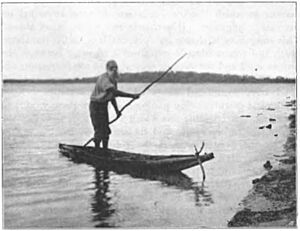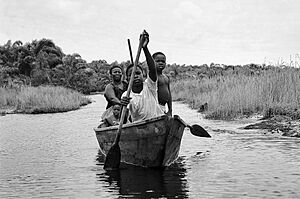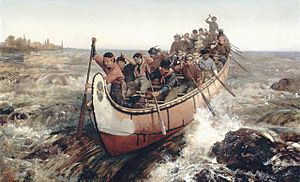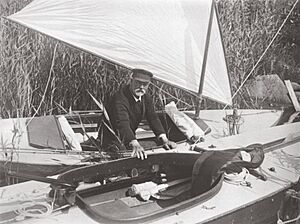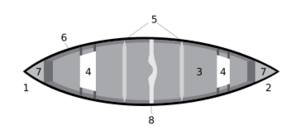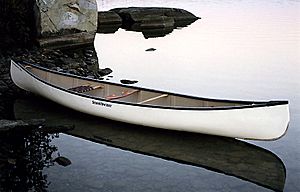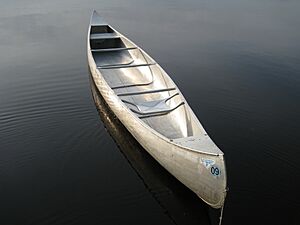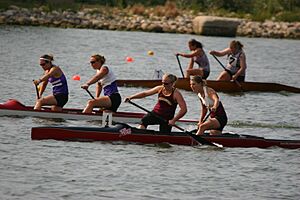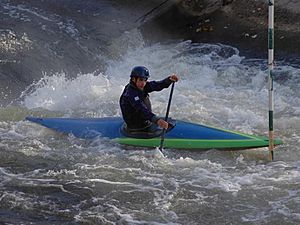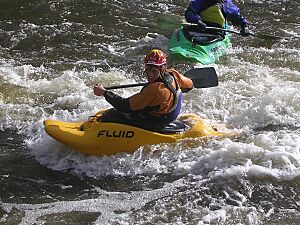Canoe facts for kids
A canoe is a light, narrow boat. It is usually pointed at both ends and open at the top. People move it using paddles while sitting or kneeling and facing forward.
In some places, like Britain, the word canoe can also mean a kayak. To tell them apart, canoes are sometimes called Canadian or open canoes. But for sports, the American way of telling them apart is usually used. At the Olympics, both words are used. Events like Canoe Slalom and Canoe Sprint have separate races for canoes and kayaks.
Contents
Canoes Around the World
People all over the world created canoes. Some were even designed to use sails or outriggers (side floats). For a long time, canoes were very important for travel and trade. In some places, they are still used today, sometimes with a small outboard motor.
Canoes are a big part of history in places like Canada and New Zealand. They are often seen in movies, books, and art. For example, the birch bark canoe helped the First Nations people in North America move around for hunting.
Today, canoes are mostly used for fun and sports. Canoeing has been part of the Olympics since 1936. People enjoy racing, going on whitewater trips, camping, and just paddling for fun.
The way a canoe is used helps decide its shape, length, and what it's made from. Long ago, canoes were often dugouts (carved from a single log) or made of bark over a wood frame. Later, they were made with canvas over a wood frame, then aluminum. Most modern canoes are made of plastic or strong materials like fiberglass, kevlar, or graphite.
History of Canoes
The word canoe came into English from a French word. That French word came from the Saint-Lawrence Iroquoians language in 1535.
Dugout Canoes
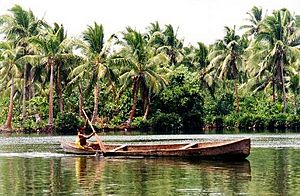
Many people throughout history made dugout canoes. They carved them from a single piece of wood, usually a large tree trunk. Dugout canoes are very old. The Dufuna canoe found in Nigeria is about 8,500-8,000 years old. The Pesse canoe from the Netherlands is about 8,200-7,600 years old.
Canoes were very important for people to reach the Caribbean Islands from South America. Around 3500 BC, ancient Amerindian groups used canoes to settle the first Caribbean Islands. Some large canoes could carry many people, even 40 to 50 people for trading.
Native American groups on the north Pacific coast made dugout canoes from cedar trees. They had different styles for different uses. Some were for ocean travel, others for rivers. Some were for whale-hunting, and others for salmon-fishing. The Quinault people in Washington State made canoes that could slide over logjams in rivers. The Kutenai people in British Columbia made canoes that were stable in windy conditions.
Recently, First Nations in British Columbia and Washington State have brought back the tradition of ocean-going canoes. Starting in the 1980s, groups like the Heiltsuk and Haida led this movement. Many canoes now paddle together in events called Tribal Canoe Journeys.
Australian aboriginal people made canoes from hollowed-out tree trunks or tree bark. People in the Amazon Basin often used Hymenaea trees.
Bark Canoes
Australia
Some Australian aboriginal peoples made canoes from tree bark. They could only be made from certain trees, like red gum, and only in summer. After cutting the bark, they would use fire to dry it and make it curl up. Then, they would stitch the ends together and seal them with mud. These canoes did not last very long, about two years. They were mostly used for fishing or crossing rivers and lakes.
Americas
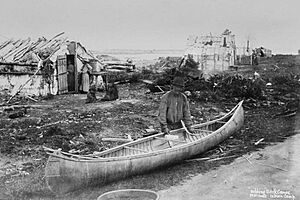
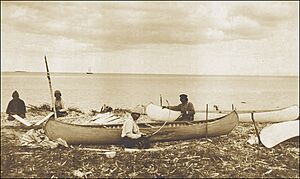
Many indigenous peoples of the Americas built canoes from bark. They usually used birch bark over a light wooden frame. These canoes were light enough to carry over land (called portaging), but they could carry a lot of cargo. They were also easy to fix if they got damaged.
Early European settlers quickly saw how useful these canoes were. Canoes played a key role in exploring North America. For example, Samuel de Champlain traveled far into Canada by canoe in 1615.
In 1603, some Virginian Indians brought a canoe to London and paddled it on the River Thames. A French explorer in 1669 said that canoes were great because you could carry them over waterfalls and then put them back in the water. The American artist George Catlin called the bark canoe "the most beautiful and light" boat ever made.
Explorers like Alexander Mackenzie and the Lewis and Clark Expedition used canoes a lot.
In the North American fur trade, the Hudson's Bay Company used different types of canoes:
- The rabaska (or "Montreal canoe") was very large. It was about 35 feet (11 m) long and could carry 60 heavy packs and lots of food. Eight or ten people would paddle it.
- The canot du nord (or "canoe of the north") was about half the size of the rabaska. It was faster and carried about 35 packs. Two men could carry it.
- The express canoe was about 15 feet (4.6 m) long. It was used to carry people, important messages, and news quickly.
The birch bark canoe was used for a 6,500 km (4,000 mi) supply route from Montreal to the Pacific Ocean. It was used until the late 1800s.
The indigenous peoples of eastern Canada and the northeast United States made canoes from the bark of the paper birch tree. They would sew the ends together and make them waterproof with tree pitch. The canoe's ribs were made of white cedar.
Skin Canoes
Skin canoes are made from animal skins stretched over a frame. Examples include the kayak and umiak.
Modern Canoes
In the 1800s, canoe makers in North America started using canvas over a wood frame. Companies like Old Town Canoe and Chestnut Canoe Company built these. They would stretch waterproof canvas over the canoe's frame. Then, they would treat the canvas with special paints to make it strong and waterproof.
Canoes used to be mainly for transport, but with new ways of making things, they became popular for fun and sports. John MacGregor helped make canoeing popular through his books. He started the Royal Canoe Club in London in 1866.
Sprint canoe became an Olympic sport at the 1936 Berlin Olympics. The International Canoe Federation was formed in 1946 to oversee canoe sports worldwide.
How Canoes are Shaped (Hull Design)
A canoe's shape, called its hull design, is very important. It affects how fast it goes, how much it can carry, how easy it is to turn, and how stable it feels.
- Length: Longer canoes are generally faster, especially for touring. A popular length for touring canoes is about 17 feet (5.2 m). This length balances carrying space and speed.
- Width (Beam): A wider canoe is more stable, but it might be slower. Canoe makers measure width at different points, like the top edge (gunwale) or where the water meets the boat (waterline).
- Sides (Freeboard): Taller sides keep water out in rough conditions. But tall sides can make the canoe heavier and catch more wind.
- Stability: Some canoes are designed to feel steady right away (initial stability). Others are designed to resist tipping over (final stability). Canoes with flatter bottoms feel more stable at first. Rounder or V-shaped bottoms are less stable at first but are harder to tip all the way over. Flat-bottomed canoes are popular for fun paddling because they are stable and can carry more.
- Rocker: This is how much the bottom of the canoe curves up from end to end, like a banana. A canoe with more rocker is easier to turn but doesn't go in a straight line as well. Canoes with less rocker go straighter but are harder to turn.
- Symmetry: A symmetrical canoe is the same at both ends. An asymmetrical canoe has a different shape at the front and back. This can help with speed.
Modern Materials and How Canoes are Built

Plastic Canoes
Folding canoes often have a PVC skin over an aluminum frame. Inflatable canoes have no hard frame. You can blow them up, deflate them, and fold them into bags. They are usually made of strong nylon or rubber with separate air chambers inside.
Royalex was a popular plastic material for canoes until 2014. It was lighter and stronger than other plastics. But it was more expensive than aluminum or molded plastic canoes.
Fiber Reinforced Composites
Most modern canoes are made by layering fiber materials inside a mold. Fiberglass is common because it's not too expensive, can be shaped easily, and is simple to fix. Kevlar is used for light, strong boats, especially for rough water. Carbon fiber is used in racing canoes to make them very light and stiff.
A clear outer layer called a gel coat makes the canoe look smooth. Some canoes are made from plywood panels stitched together. The seams are then strengthened with fiber materials. A cedar strip canoe is made of thin strips of cedar wood. It's often covered with fiberglass to make it strong and let you see the beautiful wood.
Aluminum Canoes
Before fiberglass, aluminum was a popular choice for whitewater canoeing. It's tough and strong. Aluminum canoes don't get damaged by sunlight or extreme temperatures. However, they can dent, are hard to fix, can be noisy, and need special air chambers to float if they tip over.
Canoes in Culture
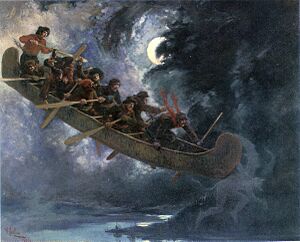
In Canada, the canoe is a big part of history and stories. It is a symbol of Canadian identity. From 1935 to 1986, the Canadian silver dollar coin showed a canoe with the Northern Lights in the background.
The Chasse-galerie is a famous French-Canadian story. It's about fur traders who make a deal with the devil to fly home in their canoe on New Year's Eve. They have to follow strict rules, like not saying God's name.
In John Steinbeck's book The Pearl, a canoe is very important to the main character. It helps him make a living and connects him to his family's traditions.
The Māori, who are indigenous Polynesian people, arrived in New Zealand in canoes (called waka). Canoe traditions are very important to Māori identity. They help explain where tribes came from and how they are connected.
Types of Canoes
Modern canoes are usually grouped by what they are used for. Many designs are "hybrids," meaning they combine features for different uses. Most canoes are for one person (solo) or two people (tandem), but some are for more.
Sprint Canoes
Sprint canoe is also called flatwater racing. The paddler kneels on one knee and uses a paddle with one blade. Canoes for racing don't have a rudder, so the paddler steers with their paddle using a special stroke. These boats are long and narrow, which makes them very fast but also very wobbly. A C4 canoe (for four people) can be up to 9 meters (30 ft) long. The International Canoe Federation (ICF) has classes like C1 (solo), C2 (two people), and C4 (four people).
Slalom and Wildwater Canoes
In ICF whitewater slalom, paddlers go down a 300-meter (980 ft) course of whitewater rapids. They must pass through up to 25 gates (pairs of hanging poles). Paddlers get time penalties for hitting poles or missing gates. Categories are C1 (solo) and C2 (tandem). These canoes are covered and paddlers kneel inside.
In ICF wildwater canoeing, athletes paddle down rough rivers with waves, holes, and rocks. Races can be long ("Classic") or short ("Sprint"). Categories are C1 and C2 for both women and men. These canoes are also covered, and paddlers kneel inside.
Marathon Canoes
Marathons are long-distance races. They can include portages, where paddlers carry their canoes over land. Rules for these races can vary. For example, the Classique Internationale de Canots de la Mauricie race uses C2 canoes with specific length and width rules. The Texas Water Safari is a very long race, about 262 miles (422 km).
Touring Canoes
A "touring" or "tripping" canoe is made for traveling on lakes and rivers. It has space for camping gear. These canoes are usually made of strong materials. They are designed to carry a lot of gear and still be easy to steer on rivers, even with some whitewater. The "Prospector" is a famous type of touring canoe. It has a good balance for wilderness trips on lakes and rivers.
Some touring canoes have a large deck that covers most of the boat, leaving a "cockpit" for the paddlers. This design can help keep the paddlers drier.
Freestyle Canoes
A freestyle canoe is made for playing and doing tricks in whitewater. They look like short, flat-bottomed kayaks but are set up for kneeling paddlers using a single-blade paddle. In playboating, paddlers do tricks in one spot, like a wave, instead of just going down the river.
Square-Stern Canoes
A square-stern canoe has a flat back end. This is so you can attach an outboard motor. These canoes are good for lake travel or fishing. They can also be easily set up for sailing.
Canoe Launches
A canoe launch is a special place to put canoes into the water. It's like a boat launch but for smaller boats. Canoe launches are often found on river banks or beaches. You might see them marked on maps in parks or nature reserves.
Photo gallery
-
Paul Kane (1810–1871): Spearing Salmon By Torchlight, an oil painting
-
Ojibwe women in a canoe on Leech Lake, 1896
-
A canoe in Kerala, India, 2008
See also
 In Spanish: Canoa para niños
In Spanish: Canoa para niños
- Umiak
- Outrigger
- Waka (canoe)
- Adirondack guideboat – looks like a canoe
- Canoe paddle strokes
- Canadian Canoe Museum
- Kennebec Boat and Canoe Company
- E.H. Gerrish Canoe Company
- Thompson Brothers Boat Manufacturing Company
- Carleton Canoe Company





